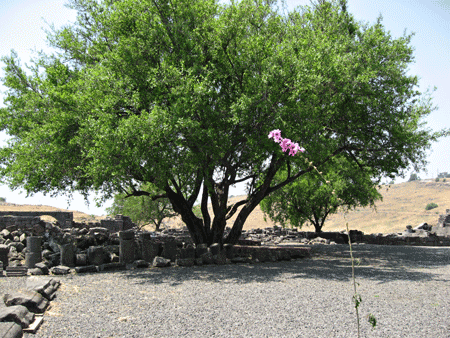|
 |
|
 |
Of the three cities – Chorazin, Bethsaida,
Capernaum – rebuked or cursed by Jesus,
Chorazin is the attention grabber, as the
first mentioned. We don’t know which
miracles were performed in this Galilean
village, 2.5 miles northwest of Capernaum.
Was it casting out demons? Healing a
withered hand? Rebuking a malarial
fever? Raising up a dying child?
But we do know that this is a wake-up call
and had the people heeded Jesus’ words, as
the wicked population of Nineveh had heeded
Jonah’s warnings, destruction would have
been averted. All three towns
disappeared off the face of the earth, until
their ruins were revealed by the
archeologists’ spade. |
|
|
|
 |
|
Photo:
Gila Yudkin |
|
Interior of Chorazin
Synagogue |
|
|
Chorazin was the first of the “cursed”
cities to be identified. In 1869 a Dutch
officer named C. Van de Velde stumbled upon
the ruins of Chorazin as he traveled
throughout the Holy Land estimating road
distances in his second career as a
cartographer. Van de Velde’s map,
published in both French and English, was
considered the best and most reliable of his
day. Undoubtedly it was incorporated
into the 19th century equivalent of Google
maps. |
|
|
|
 |
|
Photo:
Gila Yudkin |
|
Ionic basalt capital once
adorning Chorazin's synagogue |
|
|
The most astounding discovery at Chorazin
(in 1926) was a black basalt stone armchair
used in the synagogue during the reading of
the Torah. In the Acts of the
Apostles, James refers to the custom of
reading the Torah, or the Law of Moses on
the Sabbath. “For in every city, for
generations past, Moses has had those who
proclaim him, for he has been read aloud
every Sabbath in the synagogues.”
(Acts 15:21) |
|
|
|
In Chorazin and other Galilean synagogues of
Jesus’ day, during the reading of the Law of
Moses, the congregation sat on stone benches
still seen running along the side walls or
on mats on the floor. However, the
elders sat facing the people, with their
backs to Jerusalem. The most
distinguished of the elders would sit on a
stone armchair called the “seat of Moses.” |
|
|
|
This stone armchair found at Chorazin is an
exemplary illustration of the “seat of
Moses” mentioned by Jesus in Matthew 23.
“Then Jesus spoke to the multitudes and to
his disciples, saying, ‘The scribes and the
Pharisees sit in Moses’ seat.
Therefore whatever they tell you to observe,
that observe and do, but do not do according
to their works, for they do not practice
what they preach’.” |
|
|
|
 |
|
Photo:
Gila Yudkin |
|
"Seat of Moses" of Matthew
23 found in the Chorazin synagogue |
|
|
|
Here in Chorazin’s synagogue with our group
“elder” settled in the “seat of Moses” and
the others on the original stone benches, we
can talk about hypocrites, pretense, honor,
walking the talk….wherever the spirit leads
us. It’s a rare, quiet opportunity to
explore Jesus’ message in a town destroyed
because of the people’s refusal to repent. |
|
|
|
Afterwards we head for the shady old oaks,
putting ourselves in the sandals of
nineteenth century European and American
explorers who walked the land in a quest to
identify sacred geography. And let our
imaginations roam for clues that would guide
our search to locate buried biblical sites. |
|
|
|
 |
|
Photo:
Gila Yudkin |
|
Shady old oak at Chorazin |
|
|
|
Gila Yudkin,
who calls herself a Connecticut-born Yankee
living in King David’s court, leads her
groups to the most popular sites in
off-hours and takes advantage of quiet
opportunities to explore the message of the
Gospel. Gila is always on the lookout
for groups thirsty for biblical insight,
archeological anecdotes and old-fashioned
fun. |
|
|
|
When Jesus reproached the people of
Chorazin, he told them that if the mighty
works which were done in their own hometown
had been done in Tyre and Sidon, they would
have repented long ago, sitting in sackcloth
and ashes. Take a look at "Ask
Gila why those guys are wearing sackcloth"
for some insights into the ancient biblical
custom. |
|
|
|
Read what archeology has revealed about
Bethsaida in the time of
Jesus. |
|
|
|
For more about Jesus’ attitude towards
hypocrites, see “Let's consider
whether Jesus visited
Sepphoris.” |
|
|
For a ramble about the archeology of “a
city on a hill which cannot be hid,”
see “Let’s ramble through Hippos, a
Decapolis city” |
|
|
Copyright 2010 Gila Yudkin. Permission
needed for any reuse. |
|
|

